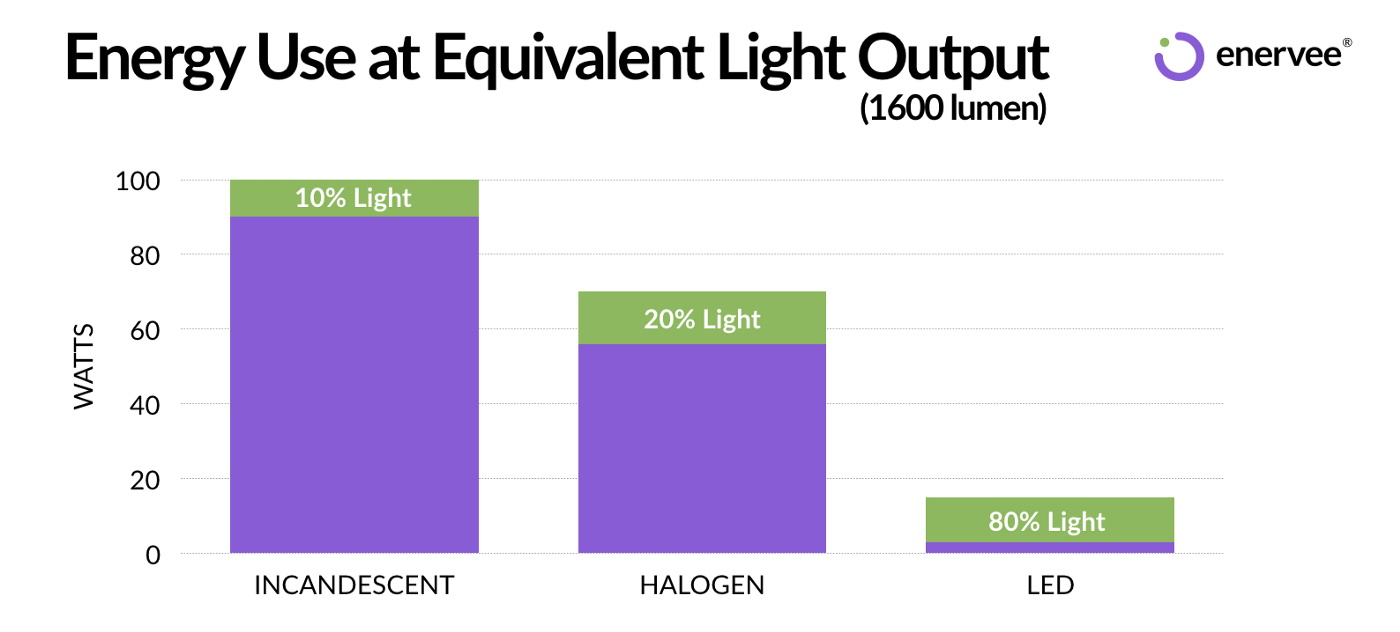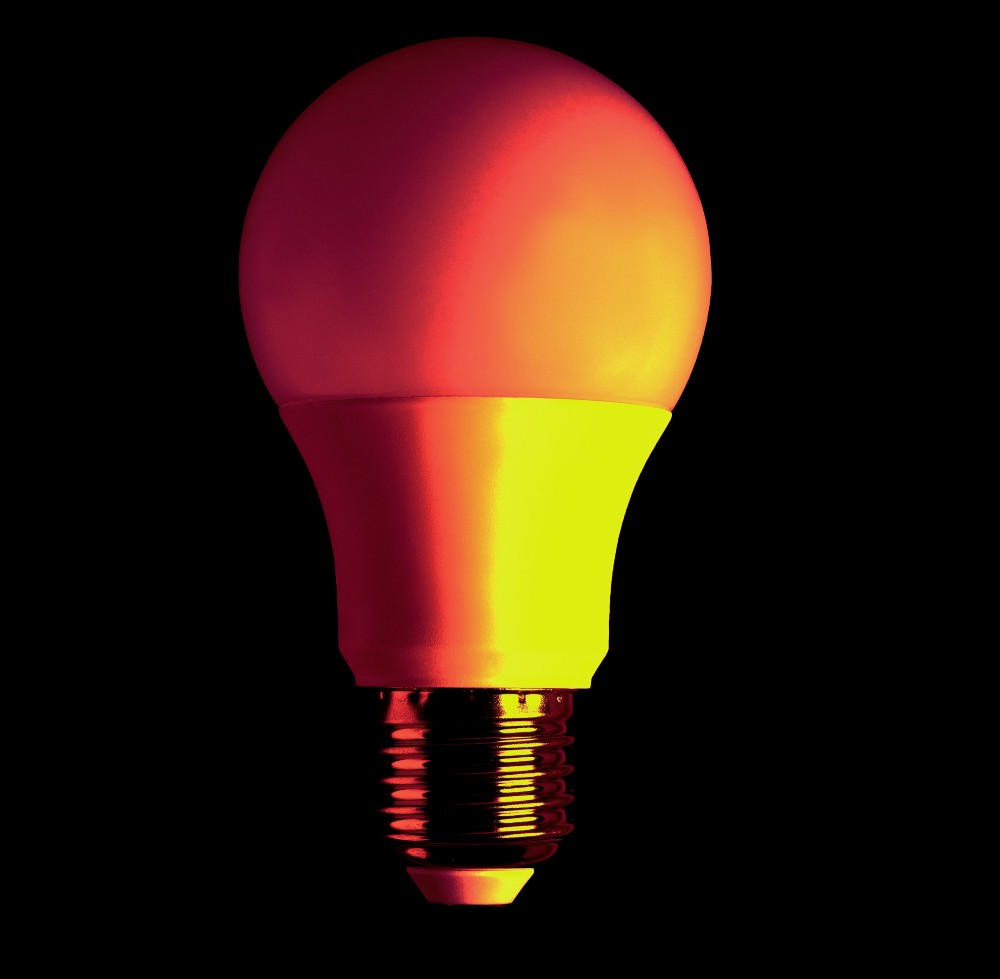With sparkling holiday lights still spreading warmth and cheer in our homes and communities, it’s perhaps an appropriate time to raise the issue of lighting energy waste.
Light bulbs are small. Their collective energy consumption isn’t.
Nationwide, lighting is responsible for 6% of total electricity bills, as much as your refrigerator, or more than your clothes washer & dryer combined [1]. Inefficient incandescent light bulbs still fill 1.5 billion sockets in the U.S., and about half of the roughly 1 billion light bulbs bought annually are still outdated incandescent technology.
Many are surprised to learn that 90% of the electricity used by an incandescent light bulb isn’t converted into visible light.

When an incandescent bulb is hooked up to a power supply, the electric current passes through a metal filament, heating it until the filament is so hot that it glows. Only 10% of the energy used by an incandescent bulb is ultimately converted to light; the rest is lost as heat, making the bulbs hot to the touch. Halogen lights also run extremely hot and produce 80% waste heat.
Bulbs that rely on LED (light-emitting diode) technology are solid state and don’t rely on heating a filament to produce light. Instead, an LED emits light when current flows through it (for those more scientifically inclined, electrons in the semiconductor recombine with electron holes, releasing energy in the form of photons).
Backtracking on bulb standards agreed in 2007
In a Grinch-like move just before the holidays, the Trump Administration announced that it will block the energy-saving lightbulb standards signed into law by President George Bush in 2007 from entering into effect as planned on January 1, 2020. The standards had broad bipartisan support and would have ensured that the over 1 billion everyday light bulbs sold in the United States every year use less energy than regular incandescent bulbs.
By blocking the energy performance standards from going into effect, the Administration’s decision could have significant negative consequences [2]:
- Cost U.S. consumers an extra $14 billion on annual energy bills (over $100 per household). Over the 15- to 25-year lifetime of quality LED bulbs, this adds up to thousands of dollars of money wasted.
- Waste an amount of electricity generated by 30 large (500 MW) power plants every year
- Emit 38 million tons of avoidable climate-warming carbon dioxide pollution every year.
…unless each of us takes the simple action to opt for LEDs.
Without updated national standards in place, the onus is now on each one of us as consumers to make the efficient LED choice.
The good news is that high-quality, super-efficient LEDs are available at affordable prices. When your next incandescent bulb burns out, Enervee’s online efficient product comparison platform makes it easy to get the best prices on the most energy efficient bulbs.
Many energy providers also offer incentives on LEDs, often in the form of in-store markdowns or instant online discounts. Here are some examples (lucky you if your utility is one of these!):
Ohio: AEP Ohio
California: Los Angeles Department of Water & Power
LEDs – What’s not to love?
Research shows that people are even willing to pay more for today’s LEDs [3], because they are superior to the less efficient technologies on many fronts beyond energy savings and climate protection:
- LEDs are available in a full range of white color temperatures and colors
- LEDs contain no mercury, harmful gasses, or toxins
- LEDs are shatterproof, shock resistant and run much cooler than incandescent and halogen bulbs, offering safety, comfort, longevity and versatility benefits
- LEDs are gentle on fabrics and artwork, because they produce little to no infrared or ultraviolet radiation, which can harm them
- In addition to providing basic lighting services, smart LEDs can deliver ambiance, contribute to home safety, support healthy sleep and waking, adjust to match the tasks at hand (e.g., studying vs. romantic dining), or enhance entertainment experiences by synching with movies, music and games

As Steve Nadel, Executive Director of the American Council for an Energy-Efficient Economy (ACEEE), put it [1]: “You wouldn’t use a phone from the 1870s, so why use Edison’s 1870s light bulb?”
For many consumers, the fact that LEDs save money is a good enough reason to seek them out. While LEDs cost a bit more at the register, they deliver greater energy returns over time – for two reasons: long LED lifetime and high energy efficiency (so LED users don’t pay for wasted energy). A person would have to buy 21 incandescent lamps with a typical lifetime of only 1,200 hours to cover the lifetime of a single 25,000-hour LED. If an incandescent bulb costs $1, one would need to spend $21 to get as many hours of light as provided by a $5 LED. In addition, at an average electricity rate of $0.12 per kWh, it will cost $30 to power a 10W LED bulb for 25,000 hours – or six times more (a whopping $180) to power the equivalent 60W incandescent bulb for the same period.
Overall, you save 83% with the LED. Even without incentives.
It’s all about choice. We can do this!
Notes
[1] U.S. residential sector electricity consumption by major end uses in 2018, as projected in the Annual Energy Outlook 2019
[2] Trump Administration Defies 2007 Law and Ties Americans to Energy-Wasting Bulbs (Press Release from ACEEE, NRDC & ASAP, 20 December 2019)
[2] California Statewide Residential Lighting Customer Decision Study Final Report (15 June 2018)

